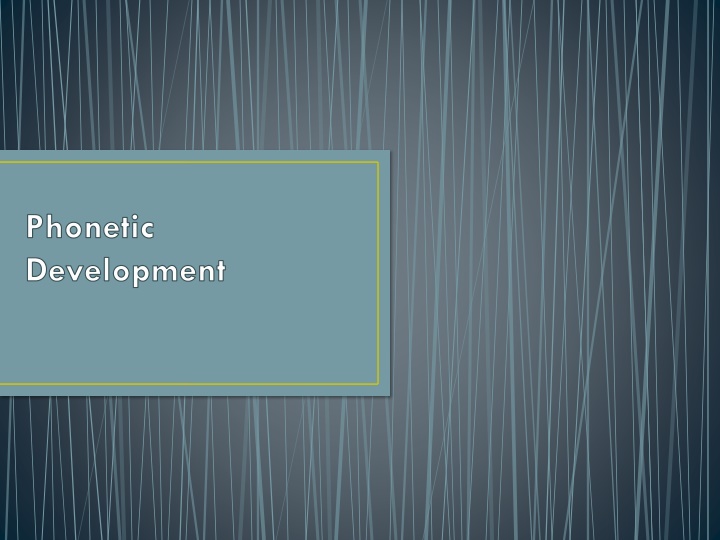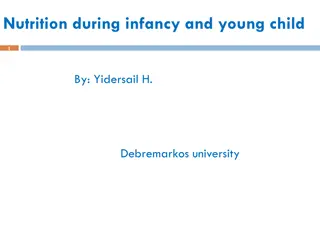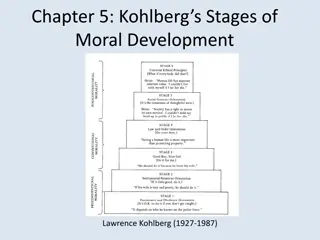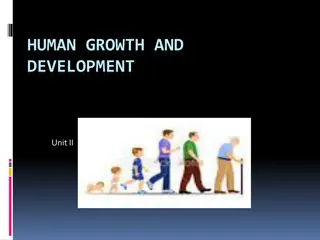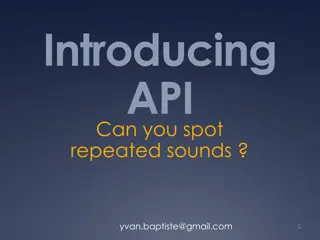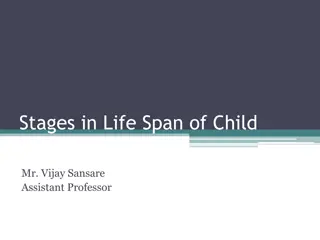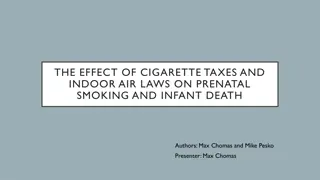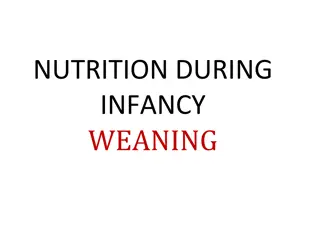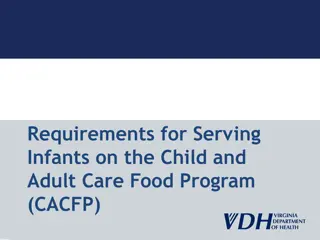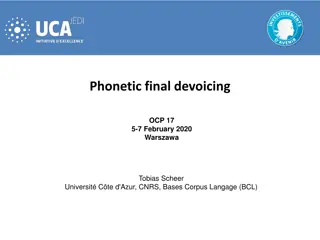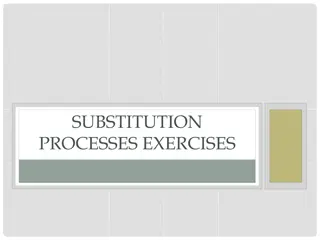Infant Phonetic Development: Stages and Characteristics
Infant phonetic development progresses through distinct stages, from basic biological noises like crying to babbling and beyond. Each stage highlights vocal milestones such as cooing, vocal play, and babbling, leading to the expansion and contraction of phonemes. The transition to melodic utterance signifies an important phase in early language acquisition. Additionally, challenges like FAVACDURDS (Fricatives, Addition, Voicing, Assimilation, Consonant Clusters, Deletion) are common as infants refine their speech patterns. Understanding these stages aids in appreciating the intricate process of language development in children.
Download Presentation

Please find below an Image/Link to download the presentation.
The content on the website is provided AS IS for your information and personal use only. It may not be sold, licensed, or shared on other websites without obtaining consent from the author.If you encounter any issues during the download, it is possible that the publisher has removed the file from their server.
You are allowed to download the files provided on this website for personal or commercial use, subject to the condition that they are used lawfully. All files are the property of their respective owners.
The content on the website is provided AS IS for your information and personal use only. It may not be sold, licensed, or shared on other websites without obtaining consent from the author.
E N D
Presentation Transcript
Phonetic Development
Early phonology Stage One: 0-8 weeks: Basic biological noises During the first few weeks, the child expresses itself vocally through crying. Different kinds of cry can be identified - hunger, distress or pleasure, for example. Cries are reflexive noises. The quality of sound is similar to a mouth-wide-open vowel such as [a]. Babies from different countries make the same sound. Also, the child can vary its rhythm and pitch patterns. Stage Two: 8-20 weeks: Cooing and laughing The sounds are quieter, lower pitched, more musical. At the beginning of this period, each segment of cooing is quite short (about 1\2 second). It consists of a short vowel-like sound usually preceded by a consonant-like sound. It is quite nasal in quality. Sounds are made like coo , goo and the reduplicated ga-ga. There is more lip movement at this stage.By now sounds are being formed in the VELAR region of the mouth ( ga-ga , coo ) and the child is becoming increasingly aware of what its mouth and vocal chords can do.
Stage Three: 20-30 weeks: vocal play Cooing sounds die down. Single vowel-like or consonant-like sounds are repeated over and over again. Several sounds are made at front of mouth [mmmm] and [nnnn] or friction sounds such as [ffff]. Consonant-vowel (CVCV) sequences are more noticeable e.g. Mama , dadadada . There is greater range of consonant-vowel sound and the nasal aspects of m and n are developing. Uvular sounds made by the back of the tongue and labial sounds formed at the lips are giving the baby a vocal work-out. The child practises the fricative sounds of f , z and s Stage Four: 25-50 weeks: babbling Ababababab\dadadada - this is reduplicative babbling and there are variegated sequences - adu, mabu. More complex friction sounds are present - s and sh . Cluster consonants are avoided - early speech prefers consonants to occur before vowels - ta rather than at . Surveys suggest still no differences in babbling between different races. The child is trying out sounds in a random manner at this stage. Babbling continues up to 18 months and often alongside real speech.
Phonemic Expansion & Contraction During the babbling phase. The number of different phonemes produced by the child increases initially. This is known as PHONEMIC EXPANSION. However, by the age of 10 months, the number of phonemes reduces (PHONEMIC CONTRACTION) and the range of sounds made by the child shrinks, becoming increasingly restricted to those of the child s mother tongue. Stage Five: 9 - 18 months: melodic utterance Melody, rhythm and tone develop. Children from different language backgrounds now sound increasingly different from each other. In the transition from pre-language to language, children produce many proto-words where the sounds are clear but the meaning is not.
FAVACDURDS F Fricatives babies struggle with fricative consonants (s, v, sh etc) and replace with stop consonants see becomes tii A Addition an extra vowel might be added to a word to allow child to use favoured Consonant-Vowel-Consonant-Vowel (CVCV) pattern V Voicing babies often voice consonants at the beginning of words pig becomes big A Assimilation (or harmonising) where a consonant or vowel becomes similar to another in the same word (dog becomes dod) C Consonant clusters are simplified to allow less alterations of place and manner in the delivery of the word eg plastic becomes p tik D Deletion consonants are often avoided at the end of words hat-ha, noise- noi U Unstressed syllable a simplification where children miss out unstressed syllables in a word - banana becomes nana R Re-duplication eg fire gin-gin. The child knows engine is a two syllable word, but repeating the same syllable within the word gives the child the chance to practise pronunciation in stages D De-voicing opposite of voicing. More likely to happen at the end of words. pig would be pik (although more likely to be bik, because of the tendency to voice consonants at the beginningof words S Substitution Velar consonants are sometimes replaced with alveolar consonants (this being easier for some babies)
